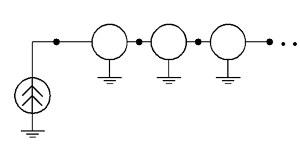Matrix d-tree method and its application for symbolic analysis of linear parametric circuits in frequency domain
DOI:
https://doi.org/10.3103/S0735272722100041Abstract
In this paper, the time of solving such SSLAR was reduced by using one of subcircuit methods, namely, topological d-tree method. The existing d-tree method is used for circuits with constant parameters; therefore, this paper proposes its modification under the name Matrix d-tree method that is extended to circuits with variable parameters. This involves the use of the notion of parametric matrix model y = 1/r, g = 1/L, and C of variables and constant elements of parametric circuit.
The d-tree method, both ordinary and matrix, provide a near-optimal taking out of similar terms in formed expressions. This result in a significant reduction of time required for their formation, decrease of the memory size required and the high operation speed of symbolic d-tree method as a whole. This leads to a significant extension of circuits admissible for analysis in terms of their complexity.
The analysis of simulation of parametric ladder circuits presented in this paper has shown a significant increase of admissible complexity of circuits using the matrix d-tree method as compared with the use of standard tools of MATLAB. This fact makes it possible to materially extend the application scope of FS-method in problems of statistical investigations or optimization of electronic devices that are simulated by linear parametric circuits.
References
- Y. Shapovalov, Symbolic Analysis of Linear Electrical Circuits in the Frequency Domain. Fixed and Variable Parameters. Lviv: LPNU, 2014.
- Y. Shapovalov, B. Mandziy, S. Mankovsky, “The peculiarities of analysis of linear parametric circuit performed by frequency-symbolic method,” Prz. Elektrotechniczny, vol. 86, no. 1, pp. 158–160, 2010, uri: https://www.infona.pl/resource/bwmeta1.element.baztech-article-BPOB-0026-0001/tab/summary.
- Y. Shapovalov, D. Bachyk, I. Shapovalov, “Matrix equation of L.A. Zadeh and its application to the analysis of the LPTV circuits,” in 19th International Conference Computational Problems of Electrical Engineering, 2018, pp. 1–5, doi: https://doi.org/10.1109/CPEE.2018.8506766.
- Y. Shapovalov, D. Bachyk, K. Detsyk, “Multivariate modelling of the LPTV circuits in the MAOPCs software environment,” Prz. Elektrotechniczny, vol. 98, no. 7, pp. 158–163, 2022, uri: http://pe.org.pl/abstract_pl.php?nid=13088&lang=1.
- B. Ho Eom, P. K. Day, H. G. LeDuc, J. Zmuidzinas, “A wideband, low-noise superconducting amplifier with high dynamic range,” Nat. Phys., vol. 8, no. 8, pp. 623–627, 2012, doi: https://doi.org/10.1038/nphys2356.
- A. Piwowar, D. Grabowski, “Modelling of the first-order time-varying filters with periodically variable coefficients,” Math. Probl. Eng., vol. 2017, pp. 1–7, 2017, doi: https://doi.org/10.1155/2017/9621651.
- P. Vanassche, G. Gielen, W. Sansen, “Symbolic modeling of periodically time-varying systems using harmonic transfer matrices,” IEEE Trans. Comput. Des. Integr. Circuits Syst., vol. 21, no. 9, pp. 1011–1024, 2002, doi: https://doi.org/10.1109/TCAD.2002.801098.
- V. P. Sigorskii, A. I. Petrenko, Fundamentals of Electronic Circuit Theory, [in Russian]. Kiev: Vyssh. Shkola, 1971.
- Y. Shapovalov, D. Bachyk, R. Romaniuk, I. Shapovalov, “Parametric matrix models of parametric circuits and their elements in frequency domain,” Radioelectron. Commun. Syst., vol. 64, no. 8, pp. 413–425, 2021, doi: https://doi.org/10.3103/S0735272721080021.
- Y. Shapovalov, D. Bachyk, K. Detsyk, R. Romaniuk, I. Shapovalov, “Frequency symbolic analysis of linear periodically time-variable circuits by sub-circuits method,” in 2022 23rd International Conference on Computational Problems of Electrical Engineering (CPEE), 2022, pp. 1–5, doi: https://doi.org/10.1109/CPEE56060.2022.9919673.
- F. Zhang, Matrix Theory: Basic Results and Techniques. Springer, 2011.
- H. Moore, MATLAB for Engineers. Pearson, 2014.
- V. P. Sigorskii, Mathematical Apparatus of Engineer, [in Russian]. Kiev: Tekhnika, 1977.
- Y. Shapovalov, “Analysis of linear periodically time-varying circuits by the frequency symbolic method with applying the D-trees method,” Przegląd Elektrotechniczny, vol. 1, no. 6, pp. 46–53, 2021, doi: https://doi.org/10.15199/48.2021.06.08.
- Y. O. Koval, L. V. Grinchenko, I. O. Milyutchenko, O. I. Rybin, Foundations of Circuit Theory. Textbook for Students, [in Ukrainian]. Kharkiv: CMIT, 2008.


